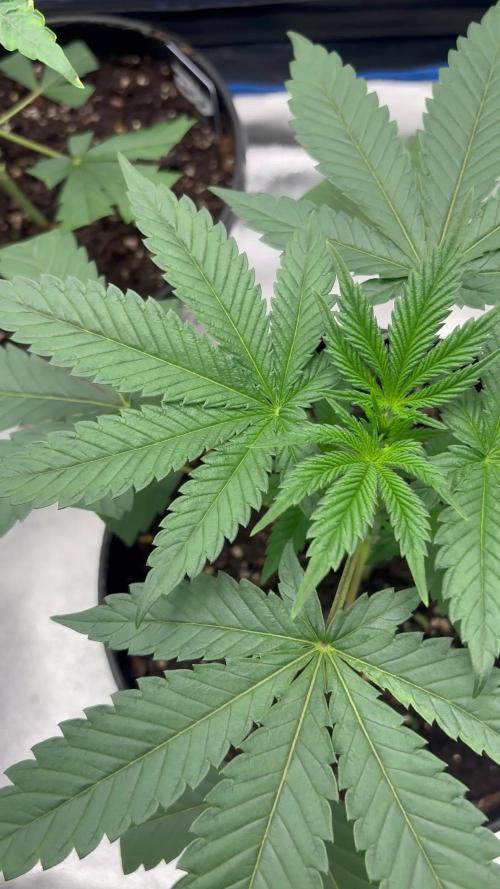The Grow Awards 2026 🏆 































Likes
Comments
Share


@ILoVeThiSpLaNt
Follow
Giorno 74
E anche l'ultima pianta (Milk Monkey) è stata raccolta.
Difficilmente coltivero indoor durante l'estate dato che sento di aver perso qualcosa in fatto di resina e terpeni visto le alte temperature. Questa pianta però rimane una bomba 💣!!! Lasciata appesa 7gg a 24° e 55% ur mi sono fumato i 3 grammi dei 103gr raccolti e già ora in bocca è un esplosione di sapori. Domina il cioccolato poi delle spezie e un fondo di gorilla glue#4. Tanta roba Exotic Genetics. Appena ho i soldi e trovo qualcosa di interessante è sicuro che compro ancora da voi.
Aggiornerò diario con foto di fumi estrazione e dei fiori secchi.
Grazie a tutti per i commenti e i like. Sono contento quando le genetiche serie vengono apprezzate ❤️😘
Likes
7
Share


@RizlaZA
Follow
2 rez top ups last week and a fully change today. Girls are thirsty and starting to really full out which is exciting me beyond examine.
WG 1 and the Haze 2 are some of the best trees I've grown.
The Wedding Gelato strain is really easy to grow and to be honest hasn't needed much from me apart from some LST and defoliation in weeks 1 and 3 of flower.
Smelling soo good and sticky as hell, definitely going to make bubbke hash from the sugar leaf and press that shit.
Processing
Likes
7
Share


@Cannibalgardens
Follow
This lady is chugging along chasing the strain next to her and has been having a bit of a hard time against this slowed growth.. I've tried less water but still it hasn't really helped yet will watch and wait for that explosion.. cheers
Likes
18
Share


@eldruida_lamota
Follow
Todo va bien el crecimiento no supone ningún problema.
Es una genetica bastante fuerte y crecen bien.
El ph está controlado y comer comer bien.
Trasplante fue un exito.
Likes
26
Share


@eriinho
Follow
hello growers"
I started the 2nd week of flora by cleaning the reservoirs, adding a new nutrient solution and adding ADVANCED NUTRIENTS BIG BUD and making a big deloliation. 👊
For the beginning of the 2nd week of flora a LOLIPOP pruning was also done.
-------
We completed another week, the buds are growing at an accelerated pace. Next week when I'm cleaning the reservoirs, I'll do a new defoliation on the girls. I'm running out of space in my tent they are growing absurdly. 👽
Likes
33
Share


@BADKUSS
Follow
Hello everyone ,
Here is the phase of completed stretch, and the fertilizer fertilizer contribution are 100%, flowering starts very well and the appearance of the first pistil are visible everywhere.
For the height of the plants I find it reasonable and thus keeping all this world a good size the luminous penetration will be excellent ... until now hene no sign of problem for my plants I think that the flowering will follow its rhythm .. to see in the coming weeks ...
now place to photos ...
Processing
Likes
19
Share


@Skunk_Life85
Follow
Added some bat doo-doo to her feed she was showing some phosphorus deficiency. Lowered the ph to 6.4 from 6.9. Hopefully fixes the issue...might have to drop the ph to 6. I know P issue arise if it's not acidic enough. Bought a microscope to check the tricromes, the only way th know for sure if she is done or not.
Likes
12
Share


@NONSENSE
Follow
Good day to everyone!
The plants look great.
☀️ The light 18/6 ☀️
🥛 The PH 5.5 🥛
💎 The EC 800ppm 💎
Growing on Rockwool is a good idea!
I see astronomical plant grow -about 2-3 cm every day. ☀️
I water the plants every day in the morning: 2L to each plant tray, then I pump the water out. ☀️
The ladies drink about 1l each every day, eating good for vegetation. ☀️
Please check the pictures- amazing leaf size, the internode is small about few cm. ☀️
I topped the plants to make more bushy forest. ☀️
Also, I installed the screen to start the ScrOG training. ☀️
After topping - I want to wait for about 4 days to lower the stress and then I will do GOOD Defoliation. ☀️
I think from the next week I will switch to 12/12. It's sativa, so I need to hurry up flowering a little to save plant size. ☀️
Good luck to every one! ☀️
Likes
40
Share


@GYOweed
Follow
Did a prune job. Got everyone to clone too. The hindsight is a beast and the SS are very bushy.
Likes
13
Share


@Weedig_Weedigson
Follow
Heute gingen die kleinen zum keimen. Ich bin gespannt wie die neue Anzuchtstation ist. Diesmal werde ich 6 Pflanzen mit Plagron Bio und 3 Pflanzen mit BioTabs, alles ganz nach schema düngen. Als Blütekammer kommt wieder die Homebox R120. Man darf gespannt sein. 😊
Leider ist eine Gorilla Zkittlez nicht gekeimt. Die hab ich durch eine Alienz von Greenhouse ersetzt
Likes
141
Share


@Tropicannibis_Todd
Follow
💩Holy Crap Growmies We Are Back💩
Well growmies we are at 35 days in and everything is going great 👌
👉 Shes a short chunky little plant 👈 We got some very pretty colors😍 👌 She's got some odd colors kinda like tiger leafing,😉
Lights being readjusted and chart updated .........👍rain water to be used entire growth👈
👉I used NutriNPK for nutrients for my grows and welcome anyone to give them a try .👈
👉 www.nutrinpk.com 👈
NutriNPK Cal MAG 14-0-14
NutriNPK Grow 28-14-14
NutriNPK Bloom 8-20-30
NutriNPK Bloom Booster 0-52-34
I GOT MULTIPLE DIARIES ON THE GO 😱 please check them out 😎
👉THANKS FOR TAKING THE TIME TO GO OVER MY DIARIES 👈
Likes
5
Share


@Ninjabuds
Follow
This was my 1st week with my new 2x2. The brand new elufah uap-1500. This light has a much better spec than my spider farmer light did. One of the plants took a little bit of stress from the spec changing but they are bouncing back. By the end of the week I should be ramping the light back up. They are some fastbuds plants so I’m sure they will love extra light.
Likes
61
Share


@BillMonroe
Follow
Dank smells and no pests or plagues going into week 9 so I'm happy. I think the fattest plant is going to be ready soon-ish. There are big differences between these 4 plants. One is very interesting with strong heavy branches, tight internodes and big leaves, and a real Haze smell. The other big yielder smells like an indica plant and is covered in trichomes.
Likes
3
Share


@Narniaman
Follow
Grow on my closet at vegetative stage with a viparspectra 300. Start in the 20 litres airpot and transplanted to 60 litres geotextil pot. At week 11 I added an apollo 6 (136w real).
Likes
37
Share


@Reyden
Follow
Sto aspettando anche per di raccogliere corbezzolo che sta asciugando da un flush con 5 litri circa di acqua 🚿 fredda (14ºC) e penso di farlo ancora tra qualche giorno e forse una settimana, che bei colori questa ragazza e un profumo molto particolare, sarà una di quelle che terrò stretto anche sono pochi grammi e cercherò di curare il più possibile prima di tirarla fuori dal barattolo! Ora intanto prepariamo il terreno per i prossimi 4 😀 ???
Likes
59
Share


@Professor_Chaos
Follow
Beginning of week...
Out of the blue.. For no reason at all.. I went ahead and topped her. The branches are already beginning to form.. so I just wanted to speed them up a little 🤷 lol.. I also removed the bottom node (leaves and branches).. They usually just don't grow like the 2nd, 3rd, etc... and the branches were not symmetrical whatsoever lol.. That really grinds my gears (it really bothers the shit outta me lol).. She is left with 3 nodes at the moment.. I will decide which nodes I want to use and go from there.. So I will be going up a tad on the Armor Si.. Up on the CALiMAGic, adding in some FloraGro, amd going up just a tiny bit on the Floralicous Plus to bring it up to the normal dose.. Still using the Hydroguard and the MYCO Plus (powder) at the normal doses.. Other than that, just been watering/feeding when the top of the medium is dry, and when you can clearly feel the weight of the pot (bucket of butter lol) is pretty much weightless.. Basically, I feed on a Monday.. Then just plain pH'd water on Thursday or Friday.. Then back to feeding again on Monday.. This will obviously change once the roots fill the pot (bucket o' margarine) within the next couple weeks or so.. Btw.. Not sure if I mentioned this already.. Dont feel like going back and checking lol.. But I put about 2 - 3 inches of just perlite at the bottom.. Not sure if this helps or does anything lol.. But I've seen other people do it.. Had some extra on hand.. Sure! Why not? I never let this sit in runoff.. Infact, when I water/feed, I place the pot on top of a cup so that she won't be sitting in runoff and so I can collect the runoff as it drips out the bottom.. So far, the runoff pH comes out a little low still.. Going in at 6.2 and the runoff will be like 5.8 or 5.7.. But, I do believe that it has been slowly making its way up.. I should really start buffering and finding a way to remove roots when I harves, so I can keep reusing and avoid issues.. Anyways.. She is happy and healthy.. Topped her and remove the bottom node.. That's all there is to report on so far.. Will be updating mid week and end of week as I usually do.. So excited!!! 😁
Mid week..
So it looks like the bottom 2 branches are triploids! I could be wrong.. But that's what it looks like to me! Can't be mad about that! Lol.. I can tell she is going to be a short thing.. Perfect for this grow box! Not sure what these weird markings are.. But this literally popped up overnight.. Will be keeping an eye on it!.. Hopefully nothing.. But we shall seeee!...
End of week...
She's doing good.. I removed the very top node that I left.. Lol.. Yeah I can be very indecisive when it comes to that stuff.. Can always just remove one later if I need too.. But yeah.. I've kinda just been tucking the top 2 branches under the bottom 2 branches so that the bottom 2 can get some good lighting too.. So I try to switch once a day or sometimes twice a day.. Once the tops grow a bit more they should all be able to get their own light without the tucking and whatnot.. But still just been feeding toward the beginning of the week and just plain pH'd water toward mid/end of the week.. The runoff pH is a little acidic.. But it doesn't seem to be hurting anything so far.. The roots have made it to the bottom of the pot.. They did a long time ago, but have really filled the pot alot already.. But I've pushed plants alot longer in much smaller (veg for 6 weeks in a 9oz solo cup).. Her branches are so thick and sturdy! She is gonna be so strong!.. I really need to make sure I don't LST too late cuz it's gonna be hard to bend these tree trunk branches.. But I'm playing with her at least twice a day, so I doubt I will miss the opportunity lol.. But I can't wait to taste some Blue Berry!!! On to the next week!...


























